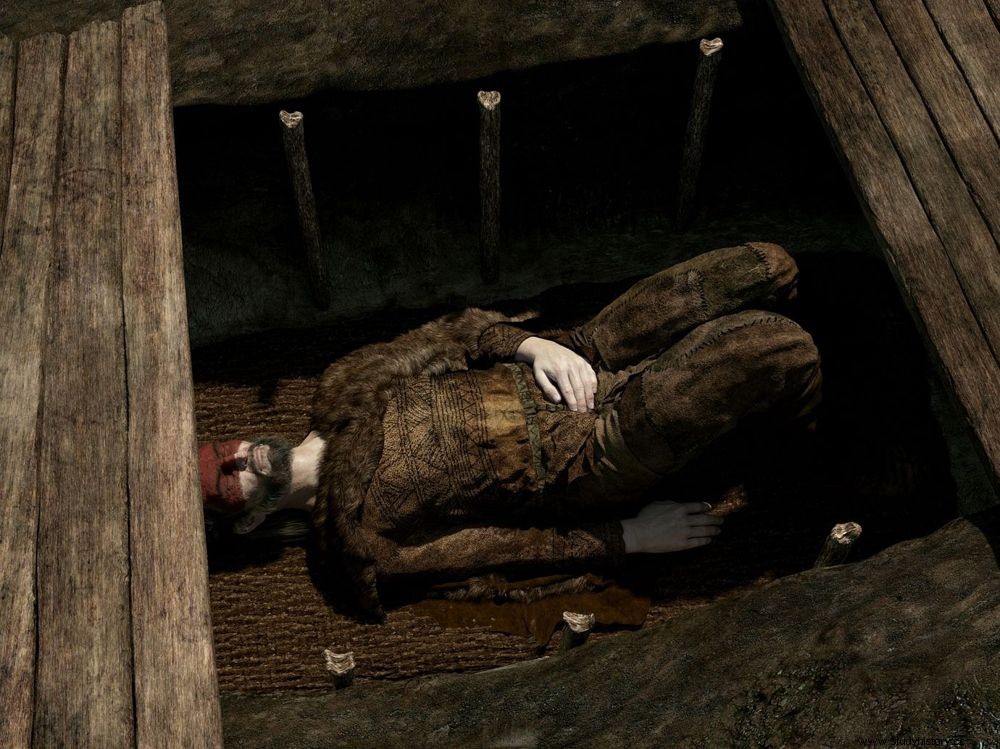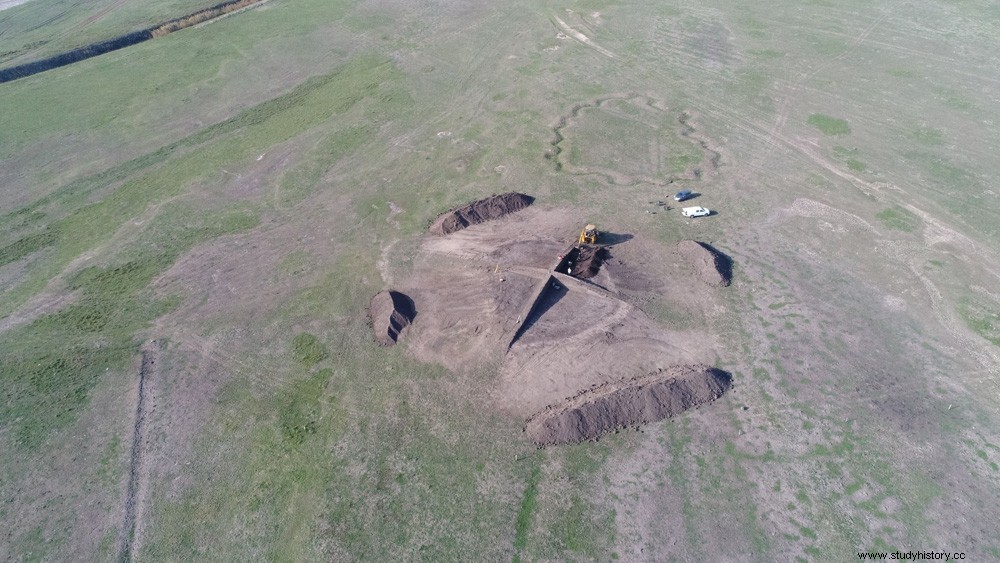Discovered in Serbia, two burial mounds dating back 5,000 years house four burial chambers typical of the Yamnaya culture, originating from the Eurasian steppe. These are the most western traces testifying to the expansion of this nomadic population.

Reconstruction of the burial of a man belonging to the Yamnaya culture, found in a sacred tumulus in Serbia.
The excavations of two burial mounds, carried out in Serbia between 2016 and 2018 by a team of Polish and Serbian researchers, revealed burials dating back nearly 5,000 years. Before announcing this invaluable discovery to the public, the archaeologists were awaiting the results of the genetic analyses, which have meanwhile confirmed the steppe origin of the men who were buried there according to the ritual specific to the nomadic peoples originating from the east of Europe, the Yamnayas. These burial mounds are the westernmost traces of their migration.
The two burial mounds were built in two stages
The two burial mounds of Šajkaš and Žabalj are located in Vojvodina, in the north of Serbia, in the plain carved out by the Tisza river, very close to where it flows into the Danube. 40 meters wide and three to four meters high, they are clearly visible in this region devoid of relief, which corresponds to the western borders of the Eurasian steppe. Originally, their dimensions were however more modest, because they were built in two stages and each corresponds to a double burial. They measured about 20 meters in diameter and two meters in height when the first deceased were buried there, between 3,000 and 2,900 BC, and it was not until 100 to 200 years later that they were enlarged, in height. as in width, to each accommodate a second burial.
On the site of Žabalj, which is the closest to the river, the archaeologists have also discovered in the earth corresponding to the elevation of the original tumulus shrapnel from the Second World War, as well as seven dwelling pits and a small hearth dug in modern times – these are the remains of the old system of fortifications built in 1944 by Hungarian and German troops, in which the tumulus was incorporated. This barrier was intended to prevent the Red Army from crossing the Tisza.

View of the Žabalj tumulus during exploration; there is a trench of the fortification dating from the Second World War . © Piotr Włodarczak / PAP
The burial chambers were built of wood
Each tumulus housed two burial chambers built of wood. The pits, rectangular in shape, were surrounded by small stakes about 5 cm in diameter; archaeologists have counted eight in the oldest pits, twelve in the most recent. The bones rested on a rectangular mat placed directly on the floor of the chamber. If the oldest pit of the Žabalj tumulus contained the mixed and incomplete remains of a male individual, the most recent, covered with a structure composed of 23 transverse beams, housed the skeleton of a man lying on his back, with legs bent to the right side. The deceased were in their forties.

The most recent burial chamber in the Žabalj tumulus. © Piotr Włodarczak / PAP
The presence of red ocher serves as the main clue
The chambers did not contain any furniture or spectacular objects, but as one of the excavation managers, Piotr Włodarczak from the Institute of Archeology and Ethnology of the Polish Academy of Sciences (IAE PAN) explains, in the absence of funerary goods, it is the red coloring of the mat and certain bones which served as the main clue to the researchers. This coloring indeed reveals the use of ocher on the bodies of the deceased, he confides to the Polish Press Agency. A natural pigment with a yellow-orange hue, ocher can also be red when it results from a mixture of clay and hematite (ferric oxide). Once considered a sacred color, it was used in funeral rituals.

Reconstruction of one of the graves. The man lies on his back, his knees are bent, his left hand is placed on his lower stomach. Red ocher is applied to the top of the face. © Micha ł Podsiadło / PAP
Men from Eastern Europe
Another clue:the size of the bones, unusual for the region. The men who then populated Vojvodina were about 1.60 meters tall, while the bones found in the graves belonged to men over 1.80 meters tall. For archaeologists, there are three factors suggesting that the men buried were certainly from other countries. More precisely, the construction of vast tumulus, the use of ocher within the framework of the funerary ritual and the superior size of the deceased seem to indicate that these men could have belonged to the tribes usually living in the eastern steppes, the Yamnayas.
Despite this concordance of indices, the researchers preferred to wait for the results of the genetic analyzes to have concrete data. DNA analyzes confirmed that the deceased were either themselves from Eastern Europe or descendants of newcomers from that region. The isotopic analyzes of the bones have also shown that their diet was based on the consumption of meat, which suggests the activity of breeders.
The funerary culture of the Yamnayas
At the turn of the 4th and 3rd millennia BC, Europe experienced a large influx of nomads from the Pontic-Caspian steppe, an immense territory stretching from the shores of the Black Sea to the north of the Caspian Sea, and included in particular the southern steppes of present-day Russia and Ukraine. Archaeologists link the traces left by these nomads to the Yamnaya culture, or "culture of the pit". Originally from around the Urals, which corresponds to the eastern half – or the Pontic section – of the steppe, the Yamnayas buried their dead in burial mounds called kurgans. If they adopted a more sedentary way of life, the migrants who went west kept their worship practices. But with the emergence, in the Bronze Age, of proto-state centers, they began to distinguish an elite, especially in their funerary practices.
Funeral rites persisted during migrations
The burial mounds were usually erected for the most important people in the community, as evidenced by the many sumptuous objects usually found in the funerary chambers:weapons, jewelry, or decorated dishes. However, the two burial mounds of Šajkaš and Žabalj contained none of this – a sign that the men who were buried there were apparently not part of the elite, even if they were duly honored. However, insofar as the other burial mounds of the Yamnaya culture found in Vojvodina are on the other side of the river, the sites of Šajkaš and Žabalj, both located on the right bank of the Tisza, are now the most western Yamnaya burials that have been discovered. They thus testify to the fact that this nomadic population succeeded in perpetuating its funeral rites to the extreme limit of its migrations.
